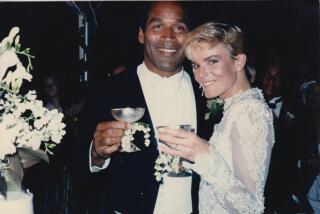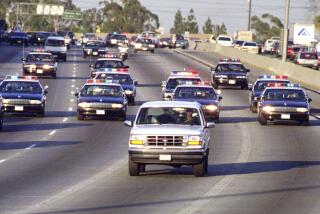DNA Tests on Blood Won’t Yield Answers for Months : Forensics: Initial matching can be done quickly, experts say. Definitive results take much longer, but they have 999,999-in-1-million accuracy.
- Share via
Laboratory comparisons of bloodstains from O.J. Simpson’s car, and driveway and the crime scene with blood from Simpson and the two victims already have yielded some results. But the techniques used to obtain such a rapid analysis are not definitive, experts said Wednesday, and results of a more conclusive DNA test will not be available for at least two months.
In addition to tests for blood type, there are other conventional tests--based on comparisons of proteins in the blood--that can show with up to 99% certainty that two blood samples are identical, and a large number of convictions have resulted from their use, said Jack Mertens, supervisor of the DNA unit at the FBI’s forensic laboratory in Washington.
Blood analysis can proceed through as many as five separate stages, Mertens said. The first critical test is to determine if, in fact, a stain is blood. That can be done in as little as 10 minutes by swabbing a small portion of the stain with chemicals that will produce a visible reaction with hemoglobin, which is present in all blood.
If the sample is blood, the next step is to dissolve it in a liquid, a process usually accomplished by allowing the sample to soak overnight. Once the blood is suspended in a solution, researchers apply antibodies to determine if it is human or animal blood. That takes about four hours.
The next step is to determine the blood type or group, a process that takes only a couple of hours. This was done in the Simpson case, but Mertens said many labs now skip this step because it yields little information. For example, If the blood is found to be Type AB, a rare group, then only 1 person in 10 in the general population would match it. But if it is Type O, nearly half the population would match.
To refine matching, researchers have started looking at enzymes and other proteins in the blood. As many as 19 different proteins, which occur in each person’s blood in different combinations, are used in this process. This analysis takes about four hours. If the pattern of proteins in blood from Simpson’s car, for example, is the same as the pattern in one of the victims’ blood, the chances are 99 in 100 that the blood in the car is from a victim.
“That’s good, but it’s not great,” Mertens said. “It’s most useful in the initial screening process when they don’t match,” meaning that two specimens come from different individuals. Such results could show that an individual did not commit a crime.
The process yields results in about two days, according to Mertens.
*
With the advent of DNA testing a few years ago, that 1% of doubt in the matching process can be greatly reduced. For that reason, the FBI lab and some others skip the conventional tests and go directly to DNA studies, Mertens said. In these tests, researchers extract DNA from blood cells, break it down into small fragments and compare the pattern of fragments.
DNA tests take longer because of their complexity, but they are usually worth waiting for. If DNA testing shows that blood from Simpson’s car matches that of his former wife, Nicole Brown Simpson, the chances are at least 999,999 in 1 million that the blood in the car is hers. The same would hold true if a blood sample at the townhouse where Nicole Simpson and her friend Ronald Lyle Goldman were slain match Simpson’s blood.
It is irrelevant that samples in a driveway or a car have dried out, Mertens said. Drying actually preserves the integrity of the samples because it helps preserve proteins and DNA, he noted. In fact, laboratories typically dry out blood samples obtained from victims or criminals before testing to ensure that all samples have been treated in a comparable manner.
More to Read
Sign up for Essential California
The most important California stories and recommendations in your inbox every morning.
You may occasionally receive promotional content from the Los Angeles Times.













